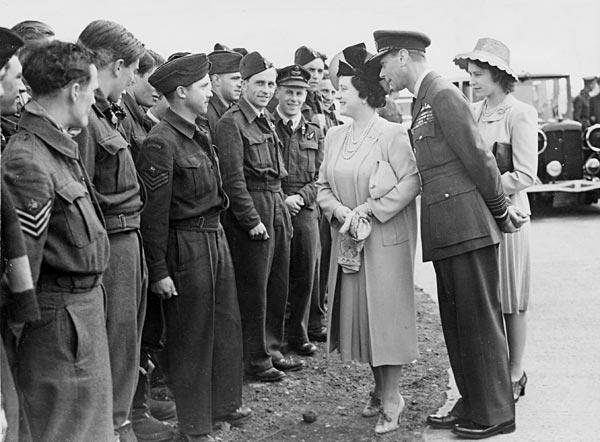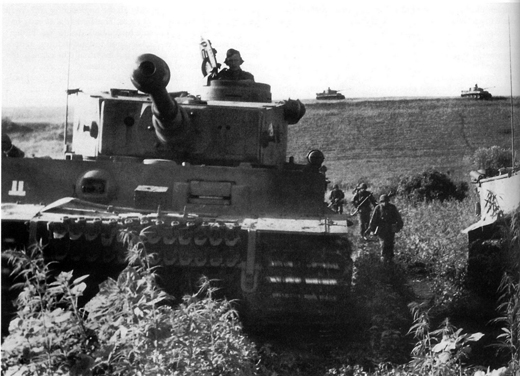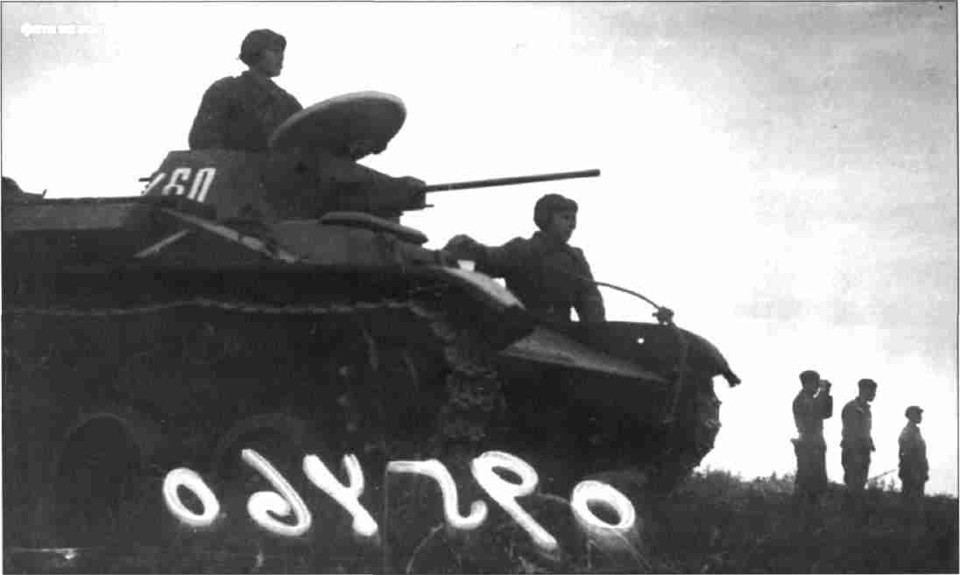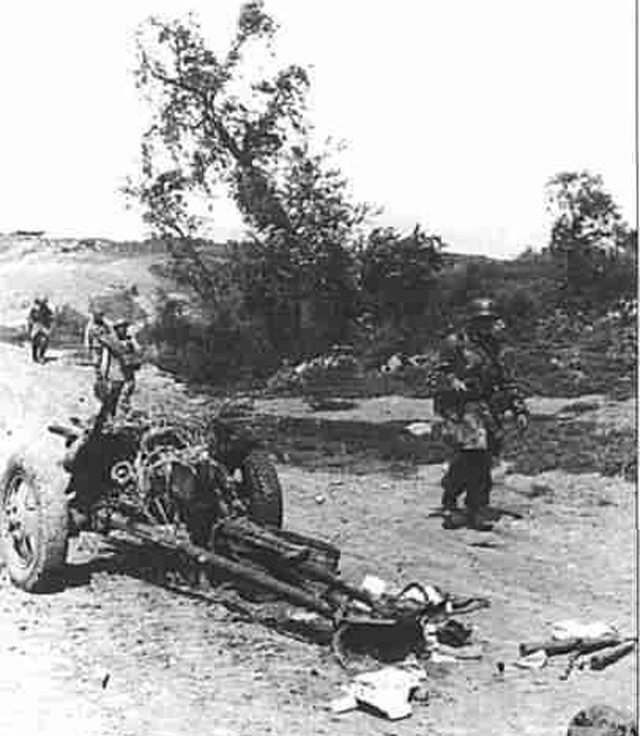Air Operations, Aleutians
6 28th Composite Bomb Group B-24s attack Kiska, but other bombers abort due to mechanical problems and failure to rendezvous with a Patrol Wing 4 PV radar pathfinder.
[Air Operations, CBI
CHINA5 11th Medium Bomb Squadron B-25s and 8 23rd Fighter Group P-40s attack the airfield at Pailochi.
[Air Operations, East Indies
V Bomber Command B-25s attack the Penfoei airfield on Timor.
[Air Operations, Europe
RAF BOMBER COMMANDEvening Ops:
- 4 Mosquitos are sent to Cologne and 3 to Düsseldorf. 36 aircraft lay mines off the Biscay ports.
- 1 Lancaster is lost.
The King and Queen with Bomber Crews |
 |
Air Operations, New Guinea
V Bomber Command B-25s attack targets around Labu Lagoon.
[Air Operations, Pacific
The Japanese bomb US troops on Rendova Island.
[Air Operations, Sicily
- Beginning before dawn, NATAF aircraft mount day-long attack against the Biscari, Comiso, Sciacca, and Trapani/Milo Airdromes.
- NASAF B-17s and IX Bomber Command B-24s attack the Gerbini Airdrom complex.
- NASAF B-25s attack the Biscari Airdrome.
- In an engagement over Gerbini about 1520 hours, 1st Fighter Group P-38s claim 7 Bf-109s as damaged or probably downed, but no victory credits are awarded.
- During the night, NATAF light bombers attack the Sciacca Airdrome.
Air Operations, Solomons
- 35 US Marine Corps TBFs and SBDs attack Japanese defenses at Bairoko, New Georgia, in support of US Marine Corps ground troops.
- During the evening, 13 307th Heavy Bomb Group B-24s attack the Kahili airfield on Bougainville, the first visit to Kahili since June 24. 7 other B-24s attack the airfield at Buka.
- 6 5th Heavy Bomb Group B-17s attack the airfield at Ballale Airdrome.
- 42nd Medium Bomb Group B-25s attack a beached Japanese destroyer.
- VF-11 F4Fs down 4 A6M Zeros over Kula Gulf between 1030 and 1040 hours.
Aleutians
The Japanese positions on Kiska are bombarded by 4 cruisers and 4 destroyers led by Rear-Adm Robert C. Giffen. This attack, the first in 11 months, is repeated several times by smaller forces over the next few days.
View from the Wichita |
 |
China
Bombers of the US 14th Air Force attack ships in ports in western China held by the Japanese.
[Eastern Front
The bitter fighting of the Battle of Kursk continues. Model's 9th Army, part of von Kluge's Army Group Center, makes slight progress, about 6 miles. The Elefant assault guns employed here suffer heavily from infantry attack as their support is destroyed and their lack of machine guns prevents effective self-defense.
|
|
Tigers of the Das Reich Panzer Division |
 |
In the south excellent artillery and air support helps achieve rather more. A heavy downpour restricts the advance here a little, especially on the left on the lower ground allocated to the front of XLVIII Corps. The 4th Panzer Army under Hoth and Kempf Operational Group of von Manstein's Army Group South, drive the Russians back 12 miles to the north. The Russian bulletin speaks of the destruction of 433 tanks and 111 aircraft. German losses are not as great as the day before, but still very high.
CENTRAL SECTORIn the northern sector of the Kursk salient both sides focus their efforts on the ridges stretching between Pomyri and the heavily defended villages of Olkhovarka and Samodurovka. The Soviet XVI Tank and XVII Guards Rifle Corps attack but are thrown back. The Russian withdrawals are followed closely by tanks of the XLVII Panzer Corps advancing to the second defensive belt held by the XVII Guards Rifle Corps' 70th and 75th Guards Rifle Divs. To the east of the line XLI Panzer Corps again tries to split the 13th and 48th Armies, but fails to do so. In the early evening the Soviets launch a counterattack, the 150 tanks of the XIX Tank Corps hitting the tip of the German 20th and 2nd Panzer Divs in the Bobrik-Samodurovka sector. The tanks are stopped by German firepower, but once again both sides suffer heavy losses. The German 9th Army has again failed to make a breakthrough.
In the south the German attack is aimed at Oboyan, launched by the 3rd Panzer, 11th Panzer and Grossdeutschland Divs following a 90-minute period of artillery preparation. The Luftwaffe flies some 200 ground-attack missions in support. However, despite 8 separate attacks by XLVIII Panzer Corps, the Germans cannot break through.
German Officer Confers with the Field Gendarmes |
 |
II SS Panzer Corps defeats the T-34 tanks of V Guards Tank Corps south of Iakovlevo, but cannot dislodge the III Mechanized Corps' 1st Guards Tank Bde and 51st Guards Rifle Div from Pokrovka and Bol'shie Maiachki on its left flank. Army Detachment Kempf attacks out of its bridgehead over the Northern Donets River with the tanks of the 7th and 19th Panzer Divs leading the way, joined later in the afternoon by the 6th Panzer Div. The 19th Panzer Div tankes Belovskoe but is halted by the last reserves of the 81st Guards Rifle Div near Iastrebovo. The lead elements of XLVIII Panzer Corps link up with those of II SS Panzer Corps near Iakovlevo, establishing a clear threat to Oboyan. In response, the Stavka orders the II and V Tank Corps from the reserves to reinforce the Voronezh Front. The front's plans for dealing with the German threat are as follows: XXXI Tank Corps will advance toward the right flank of II SS Panzer Corps, II Tank Corps and V Tank Corps will threaten the SS left flank, while VI Tank Corps and III Mechanized Corps will hald XLVIII Panzer Corps progress on the Oboyan road.[MORE]
[New Georgia
The task group of Rear-Adm Walden L. Ainsworth engages in a second encounter with the Japanese in Kula Gulf. Just before dawn, three light cruisers and four destroyers engage a Japanese reinforcement force of seven destroyers. Four of the enemy ships are carrying troops and supplied to Kolombangara. Japanese destroyers sink a light cruiser, and one Japanese destroyer is sunk and three destroyers are damaged by gunfire. One of the damaged troop-carrying destroyers is grounded and abandoned on the southeastern coast of Kolombangara. SBD Dauntless dive-bombers, TBF Avenger torpedo bombers, and F4F Wildcats will later bomb the grounded destroyer. This battle of Kula Gulf cuts off the Northern Landing Group from supply and naval gunfire support.
The 3rd Battalion of the 148th Infantry moves to block the Bairoko Trail while the rest of the group moves toward Enogai Inlet. The Southern Landing Group begins a cautious advance into the jungle from Zanana Beach.
[Pacific
The US submarine Permit (SS-178) sinks the Japanese merchant cargo ship No. 33 Banshu Maru (737t).
[Solomons
A second Japanese destroyer is sunk by aircraft on the second day of action in the area. Bougainville becomes the target of a series of raids by US bombers in an effort to knock out the airfields there. The raids gradually grow stronger; medium bombers often accompany the heavy bombers to hit more and more often the enemy shipping operating in the area. 2 regiments of the 43rd Div are already established on New Georgia, concentrated near the Barike River. Some battalions are trying without success to force the Japanese block on the track from Zanana to Munda.
The US Cruiser Helena |
 |

